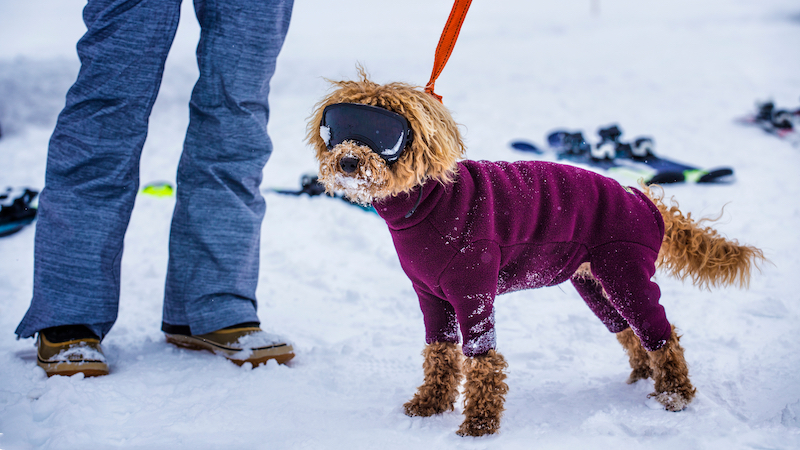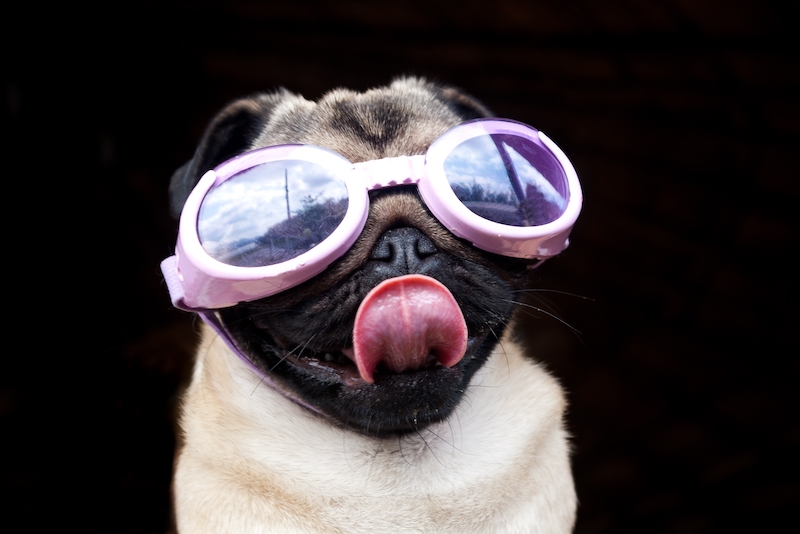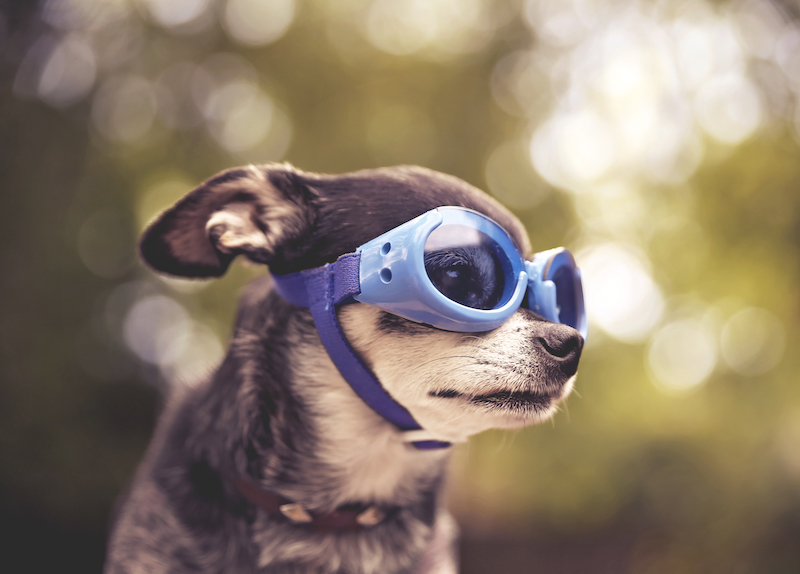Doggles
A closer look at the ultimate eye accessory for your four-legged friend.

A closer look at the ultimate eye accessory for your four-legged friend.

Dog sunglasses and dog goggles (aka ‘doggles’) are the next big thing in the world of pet accessories.
This type of canine eyewear can help prevent your dog from squinting into the sun, and stop the wind from blowing dust and debris into their eyes—plus, they’re adorable.
Let’s take a glance at what doggles have to offer, and what to consider if you’re thinking about getting a pair for your pooch.

Whether or not your dog actually needs protective eyewear depends on several factors—like their specific lifestyle and condition.
Just like humans, dogs’ eyes are vulnerable to damage from prolonged exposure to UV rays. Small dogs and large dogs alike can suffer from conditions like cataracts and pterygium (aka surfer’s eye) if they spend too much time squinting into the sun.
High-quality protective eyewear can help safeguard your pup’s eyes from the sun, especially if they spend a significant amount of time outdoors.
Doggles can act as wind protection for your pooch’s eyes. They can also block dust and debris, helping prevent eye infection and lacerations.
So if your dog is a hardcore skateboarder, or likes cruising in the car with the windows down, you might want to consider strapping them into a pair of doggles to protect their peepers from the elements.
If your four-legged friend just had an eye procedure—like cataract surgery—doggles can help protect their eyes during the healing process, and prevent them from pawing or scratching at their eyes.
Doggy goggles can provide a sense of confidence and security for visually impaired and blind dogs.
Adding that extra layer of protection could also put your own mind at ease, since it can open your pup’s world to explore more freely, while lowering their risk of injury and irritation (like if they’re sniffing around in areas they can’t see).

There’s a lot more to picking the best dog goggles for your fur fam than finding a pair that flatters their face (and matches their outfit).
Get a better understanding of what your dog needs from their eyewear, based on things like:
Consider these specs when shopping for the perfect pair for your pooch.
Dog eye protection becomes crucial as harmful UV rays increase, especially during the summer. Doggles with UV protection offer a buffer between your pet’s sensitive eyes and the harsh sunlight.
Look for options that block both UVA and UVB rays.
It’s important to find the perfect fit for your dog’s head. If the doggles are too big, for example, they might slide off or not properly protect your pooch’s eyes. On the other end, if they’re too small, they may pinch or put pressure on your dog’s face.
Your dog’s breed—which determines their facial structure—can impact which type of eyewear is most suitable.
Medium dog breeds—like Labradors, Golden Retrievers, and Beagles—have proportionally sized faces, and standard sizes and shapes typically fit them well.
Small breeds—like Chihuahuas, Toy Poodles, or Yorkies—have more petite facial structures, and need smaller frames with adjustable straps.
Breeds with flatter faces—like Pugs, Bulldogs, and Shih Tzus—may need a shorter lens-cup depth and more pronounced curvature than the standard.
Breeds with longer snouts—like Dachshunds, Collies, or Greyhounds—have a more elongated facial structure, which typically require a longer lens-cup depth to fully cover the eyes.
Remember that not all dogs within a breed will fit the typical facial structure, and mixed breed dogs could have even more variation. Measure your dog’s head to ensure a good fit, including:
Consult sizing charts, and if you’re unsure, consult with a professional—like your vet—about the right doggles for your pup.
There are specific features that can help ensure your pooch’s comfort in their eyewear, including:
Make sure your dog’s goggles can withstand the elements—and your pup’s activity level—with features like:
The price tag for doggles can vary significantly depending on factors like the brand, quality, features, size, style, and where you buy them.
For example, doggles can range from roughly $10 for more basic models from NVTED and QUMY dog goggles, to about $100 for more high-end brands like Rex Specs dog goggles for active and working dogs.
And if you’re looking to get your pooch prescription lenses (for both eyes), a pair of Doggles Originalz could run around $400.
Keep in mind that the cost of doggles—or any dog eyewear—likely won’t be covered by a pet insurance policy.

Introducing a dog to eye gear can require lots of time, patience, and persistence. Every dog’s experience will be unique, but this step-by-step guide might help you and your pooch through the process:
The most important thing is that it’s a positive process for your dog, and that you never force your dog to wear doggles if they’re distressed or uncomfortable.
Helping protect your pooch from the elements doesn’t have to stop at their eyes. Did you know that you can cover your dog from nose to tail with a Lemonade pet insurance policy?
A base policy helps take a bite out of vet bills for diagnostics and treatments related to accidents and illnesses (provided those occur after your policy’s waiting period has ended). And you can easily customize your pup’s policy with our preventative care packages and optional add-ons to meet the unique needs of your pup, all with your budget in mind.
Click below to get your quote started.
A few quick words, because we <3 our lawyers: This post is general in nature, and any statement in it doesn’t alter the terms, conditions, exclusions, or limitations of policies issued by Lemonade, which differ according to your state of residence. You’re encouraged to discuss your specific circumstances with your own professional advisors. The purpose of this post is merely to provide you with info and insights you can use to make such discussions more productive! Naturally, all comments by, or references to, third parties represent their own views, and Lemonade assumes no responsibility for them. Coverage may not be available in all states.
Please note: Lemonade articles and other editorial content are meant for educational purposes only, and should not be relied upon instead of professional legal, insurance or financial advice. The content of these educational articles does not alter the terms, conditions, exclusions, or limitations of policies issued by Lemonade, which differ according to your state of residence. While we regularly review previously published content to ensure it is accurate and up-to-date, there may be instances in which legal conditions or policy details have changed since publication. Any hypothetical examples used in Lemonade editorial content are purely expositional. Hypothetical examples do not alter or bind Lemonade to any application of your insurance policy to the particular facts and circumstances of any actual claim.